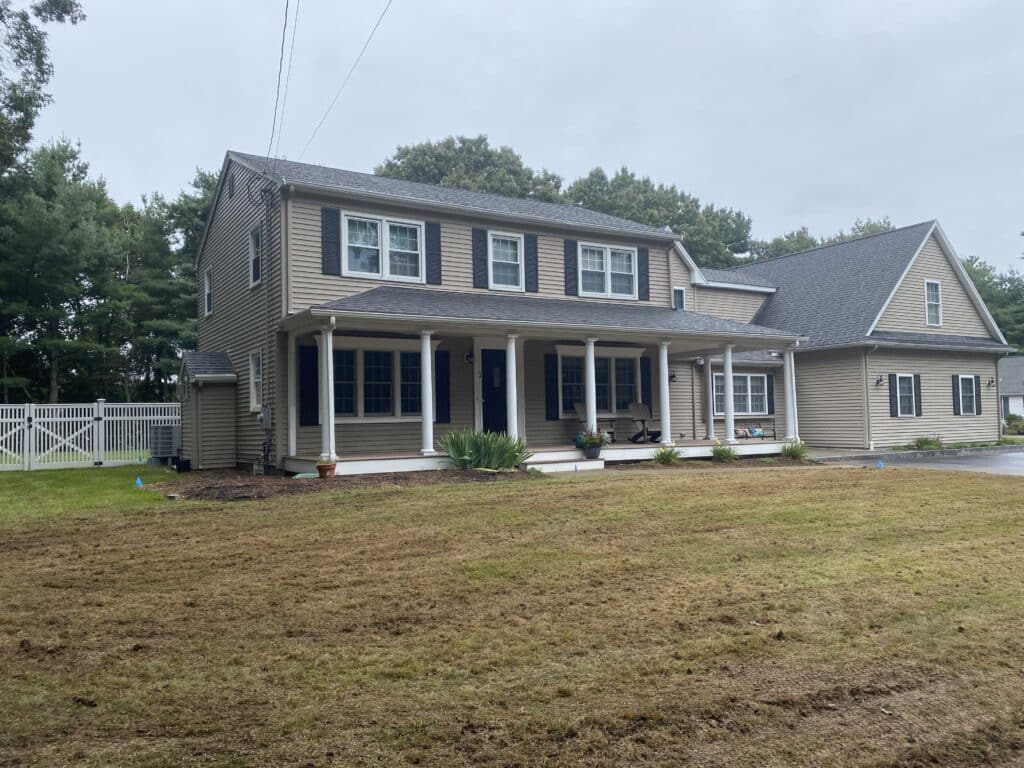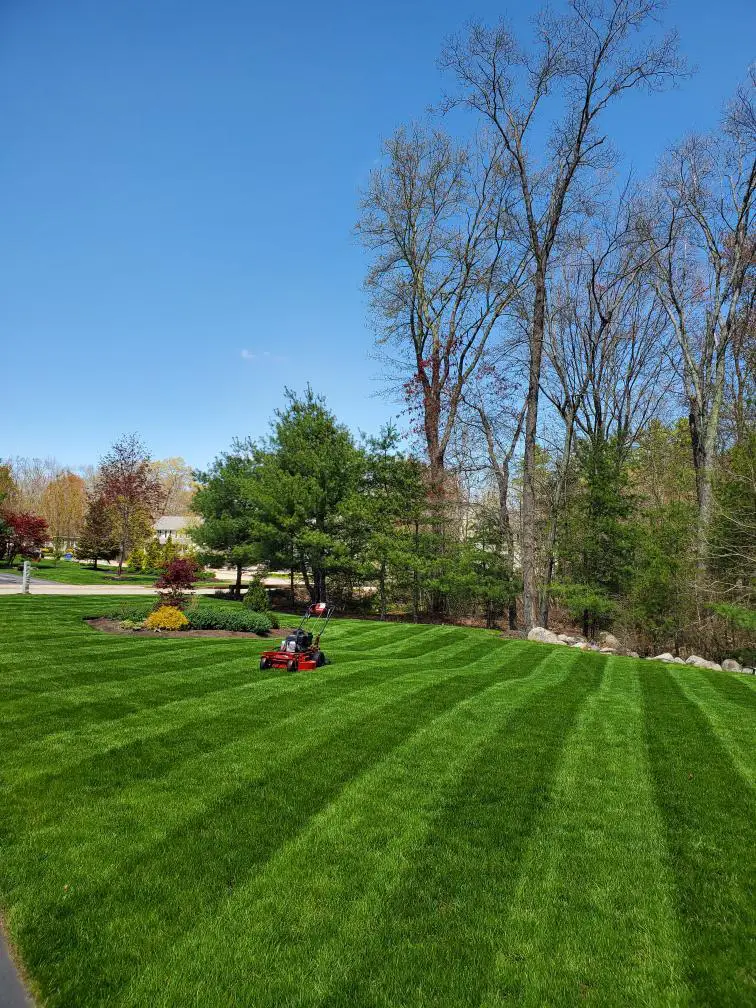Table of Contents
The dog days of summer are winding down and it’s time to take a step back and figure out this whole August lawn care thing. There are so many things that could have transpired in our yard over the past four months of the growing season, all of which could dictate which lawn care direction to go for the rest of the summer.
For example, your tall fescue and cool-season lawns may have taken a beating this summer from grubs, brown patch, or stresses from the heat and drought. This means a lot of lawn repairs, seeding, and ongoing maintenance.
You may have had escaped the damages of the summer, but have had some pesky weeds in your yard. This could steer you in the direction of core aeration to relieve soil compaction and a late summer pre-emergent application to prevent poa annua next year.
Regardless of what happened, here’s an outline of my month-by-month lawn care calendar for August lawn care.
Lawn Insects
Your lawn won’t tolerate grubs (native June bug larvae) sod webworms, chinch bugs, or any pests – especially if you did not apply insecticide prevention or grub control products in the spring. If you have lawn damage from grubs, you’ll be seeing it now. Grubs live in the soil and eat the grassroots which ultimately kill the turf. Irregular brown patches of grass that will peel back and lift up like a carpet. Apply Dylox evenly across your entire lawn and water deeply. This will quickly take care of your grub problem. For sod webworm issues, you can also spray liquids like Bifenthrin. However, lawn repairs might be needed depending on the insect damage.
Lawn Fungus
If you have tall fescue and have not been diligent about your lawn fungicide regimen, then your lawn may be experiencing brown patch or other lawn diseases. The best 1-2 punch of fungicides is Artavia 2SC and Propiconazole. Rotating these two products can quickly stop and reverse the spread of diseases.
Do not fertilize with a nitrogen fertilizer as this can feed the fungus and cause it to spread. You can apply summer survival along with liquid iron to help mitigate the stress, too. Bag your clippings when you mow and always clean your mower deck.
Summer Stress
The heat and drought stress of the summer may have taken their toll on your lawn. Seeing brown patches of grass could be a sign of drought stress. Treat this with fungicides (such as Azoxystrobin or Propiconazole mentioned above), depending on the fungus.
Do not fertilize with a nitrogen fertilizer. If your lawn is dormant or stressed, you do not want to force any growth. However, begin to incorporate more humic acid, sea kelp, and sulfate of potash (potassium). This type of fertilizer will promote healthy growth by incorporating more micronutrients into the soil. Like the previous fungicide section, use summer survival and liquid iron.

Lawn Maintenance & Fertilization
If you’ve been following my lawn care plan, then you should have little to none of these issues stated above. You should have a healthy lawn with rich soil, deep grassroots, and lush green grass blades.
You still want to continue to mow high, but being to adjust your mower height. It’s good practice to mow high in the summer, but over time, your lawn needs to get shorter especially as we inch closer to our annual lawn maintenance and repair timeframe. Keep up with your mowing frequency – shooting for twice per week if your lawn is healthy and growing.
Continue watering your lawn. While the summer is nearing its end, there are still plenty of hot and dry days ahead. As always, deeply and infrequently, and in the early mornings to keep the moisture in the soil. Aim for 1″ per week.
Apply a fertilizer with higher nitrogen and potassium. You probably skipped fertilizing in July, so now is an ideal time to fertilize and add some more nutrients back into the soil and plants.
Lawn Renovations
If you’re looking to start over, then now is the time to do so. I have a full detailed post about how to renovate your lawn here that will walk you through, step-by-step. But for now, begin by killing off your existing grass with glyphosate by the middle of August. This is going to take two applications. Begin to prepare your soil (clearing, leveling, etc.) and absolutely buy your grass seeds early. Finding the right grass seed can be difficult this time of year (simple supply & demand) so be sure to buy them now.

Core Aeration & Overseeding
Late summer and early fall is the best time for core aeration and overseeding your lawns. This step is likely done in early September and into the early fall but can be started in late August (late summer). The days are getting shorter and temps are beginning to drop – this is the ideal environment to grow deeper roots on your new grass without having to compete with grassy or broadleaf weeds. Your grass will
Core aerate your lawn – pulling soil plugs with a machine is much better than using a tow-behind spike aerator or others that also use tines/spikes.
Late August Pre-Emergents
Late summer is also a great time to control annual weeds in your lawn – or more specifically annual grasses such as poa annua. If you’ve applied Prodiamine in the early spring to prevent crabgrass and other weeds, you may have reached your max application rates for the year. If so, try Pendulum. This late summer and early fall preventative application should be a good start at preventing poa annua next year. But please remember, you cannot seed your lawn when applying these pre-emergents. Core aeration is OK prior, but these selective herbicides will prevent your grass seed from germinating. So it’s one or the other here.
August Lawn Care FAQs
What should I put on my lawn in late summer?
If you have noticeable grubs or grub damage in your lawns, apply Dylox. If there are no signs of brown patch fungus, apply fertilizer – particularly one with a higher potassium percentage. This is also a great time to apply micronutrients such as humic acid, sea kelp, molasses, and iron.
Should you fertilize lawns in August?
As the temperatures begin to cool down at this time of the season, fertilizing your lawn is a good idea. Apply approximately a half-pound of nitrogen per 1,000 square feet. Also, increase the potassium as this can help treat any stressed areas of the lawn from the summer heat.
Can I treat grubs in my lawn in August?
If you didn’t apply anything for grubs in the spring such as Acelepryn, then you are at higher chances of seeing grubs in your lawn. If so, apply Dylox at the first signs of grubs or grub damage.

